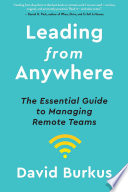

Collaboration can be challenging in remote teams, but the book offers practical tips for fostering a collaborative culture. It emphasizes the importance of creating opportunities for informal interactions, such as virtual coffee breaks or team-building activities. Leaders are encouraged to leverage technology to create shared spaces for brainstorming and problem-solving. By promoting a sense of belonging and camaraderie, organizations can enhance creativity and innovation among their remote workforce.
Continue readingThe traditional methods of performance management may not be applicable in a remote work environment. The book advocates for a shift towards outcome-based evaluations rather than time-based metrics. Leaders should focus on setting clear goals and expectations, providing regular feedback, and celebrating achievements. This approach not only empowers employees but also aligns their efforts with the organization's objectives, fostering a culture of accountability and continuous improvement.
Continue readingCommunication is the lifeblood of any organization, but it takes on new dimensions in a remote context. The book provides insights into various communication tools and platforms that can enhance team interactions. It stresses the importance of clear, concise messaging and encourages leaders to be proactive in their communication efforts. Additionally, the book highlights the need for regular feedback loops and encourages leaders to cultivate an atmosphere where team members feel comfortable sharing their thoughts and ideas.
Continue readingThe book emphasizes that remote work has transitioned from a temporary solution to a permanent aspect of the work environment. Organizations must adapt to this reality by implementing policies and practices that support remote teams. This includes investing in technology that facilitates communication and collaboration, as well as fostering a culture that values trust and accountability. Leaders need to embrace flexibility and offer employees the autonomy to manage their work-life balance, ensuring productivity while respecting personal boundaries.
Continue readingTrust is a cornerstone of effective leadership, and it becomes even more critical in a remote setting. The book outlines strategies for leaders to build and maintain trust with their teams, such as regular check-ins, transparent communication, and recognition of individual contributions. By demonstrating vulnerability and openness, leaders can create an environment where team members feel safe to express their ideas and concerns. This trust not only enhances collaboration but also boosts morale and engagement among remote employees.
Continue readingDiversity and inclusion are essential components of a thriving workplace, and the book highlights how remote work can enhance these aspects. By removing geographical barriers, organizations can tap into a broader talent pool, leading to diverse perspectives and ideas. However, leaders must be intentional in their efforts to create an inclusive environment, ensuring that all voices are heard and valued. The book provides strategies for promoting diversity and inclusion, such as equitable hiring practices and creating channels for underrepresented groups to share their experiences.
Continue readingTechnology plays a crucial role in enabling remote work and effective leadership. The book discusses various tools and platforms that can enhance collaboration, communication, and project management. Leaders are encouraged to stay abreast of technological advancements and to leverage these tools to streamline processes and improve efficiency. Moreover, the book emphasizes the importance of training employees to use technology effectively, ensuring that everyone is equipped to thrive in a remote work environment.
Continue reading